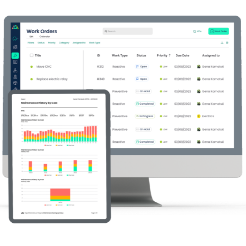
Unified Namespace + CMMS: Building an Integrated Asset Ecosystem
Sometimes it feels as if technology is expanding at the speed of light. This is an overstatement, but the reality is that as new technologies emerge, organizations are often left with little choice but to adapt to and integrate them into their operations. The reason is straightforward: failing to keep pace with new technologies can make it even more challenging to stay ahead in highly competitive markets.
Yet, despite companies’ significant investment in digital transformation to improve asset reliability, reduce unplanned downtime, and accelerate decision-making, many still operate within fragmented architectures, where critical data resides in isolated systems such as SCADA, ERP, MES, and CMMS platforms. These are known as data silos. This lack of interoperability leads to inefficiencies, delayed responses, and missed opportunities for predictive maintenance. According to a report by Deloitte, nearly 70% of manufacturers cite integration challenges as a key barrier to the successful implementation of digital transformation initiatives.
The solution to the data silos problem lies in a Unified Namespace (UNS), which provides a centralized, structured layer where all plant floor and enterprise systems can publish and subscribe to real-time data. It is not a database, but a dynamic, standardized information model that is often built using open technologies such as MQTT, Sparkplug B, and industrial platforms like Ignition by Inductive Automation.
Then there are Computerized Maintenance Management Systems (CMMS) that have evolved into critical tools for managing asset lifecycles, work orders, spare parts, and compliance. However, most CMMS platforms operate on historical or manually entered data, making them reactive rather than predictive. A solution exists, and it involves integrating CMMS with a Unified Service Management (USM) system to transform the maintenance function into a proactive, insight-driven operation. In doing so, it creates a unified asset ecosystem where maintenance, operations, and IT departments can collaborate with a shared, real-time understanding of asset health and performance. This approach enables organizations to reduce mean time to repair (MTTR), extend asset lifespans, and improve operational agility.
This article will examine the intricate relationship between a CMMS and a UNS, enabling the critical task of asset management.

The Role of Unified Namespace in Asset Management
In essence, UNS acts as a centralized repository where all industrial data—ranging from machine sensors and PLCs to ERP systems and cloud platforms—is published, subscribed to, and always accessible in real-time. Rather than data being siloed in separate systems, the UNS consolidates it into a single, organized structure using standard industrial protocols, such as MQTT and Sparkplug B. This structure creates a real-time, contextualized view of operations across an entire facility or enterprise. When it comes to maintenance and operations, this means teams have immediate access to accurate, up-to-date information that reflects the actual state of assets, equipment, and workflows. It removes the need to navigate through disconnected systems and outdated records.
With respect to asset management, the UNS serves as the digital framework that connects everything from predictive maintenance sensors to energy usage logs. It standardizes how data is labeled and interpreted, which is crucial for achieving interoperability between different software systems and devices. With all asset-related data brought together and easily accessible, organizations no longer experience the limitations of manual data transfers, spreadsheet-based tracking, and fragmented communication. Maintenance managers can view equipment condition in real-time and align their actions with production data, enabling them to respond more quickly and precisely to emerging issues. The benefit is that the UNS enhances maintenance team collaboration and leadership decision-making, and lays the foundation for a comprehensive asset ecosystem.
Understanding CMMS and the Importance of Integration
To understand how a CMMS works with a UNS, we need to review its purpose and functions. A CMMS is a software platform designed to streamline the planning, execution, and tracking of maintenance activities like work orders, inspections, and preventive maintenance across the organization. CMMS software provides a structured approach to scheduling preventive maintenance, managing work orders, tracking spare parts inventory, and documenting asset history. As noted earlier, while CMMS platforms offer incredible value by reducing equipment downtime, extending asset life, and improving compliance, they often operate in isolation from other critical data sources. The lack of connectivity places limitations on its effectiveness, especially in environments where real-time insights are key to proactive maintenance and operations.
A Unified Namespace is an effective way to overcome these limitations. When a CMMS is connected to a UNS, it becomes a dynamic, data-driven decision-making tool. Instead of relying on manual data entry or delayed information from other systems, the CMMS can draw real-time asset condition data directly from a facility via the UNS. This integration enables features like automated work order generation triggered by sensor data, streamlined diagnostics based on contextual data, and predictive maintenance insights powered by machine learning. The result is a maintenance ecosystem where operations, engineering, and maintenance teams are aligned through a single, reliable source of truth.
The integration of CMMS with a UNS not only breaks down traditional data silos but also enhances transparency across departments. This integration reduces human error, speeds up response times, and enables more precise asset management strategies that align with broader organizational objectives.
Benefits of Integrating Unified Namespace with CMMS
Integrating a Unified Namespace with a CMMS offers organizations a new level of visibility and control over asset performance and maintenance operations. One of the key benefits is the creation of a centralized, real-time data environment that allows all stakeholders to access the same accurate, up-to-date information at any time. This reduces the chances of miscommunication, minimizes data discrepancies, and enables maintenance teams to make faster, more informed decisions. Having a seamless flow of accurate and up-to-the-minute information eliminates unnecessary delays and improves response times, thus reducing unplanned downtime.
Another advantage of the Unified Namespace-CMMS integration is the activation of predictive and condition-based maintenance strategies. No longer relying solely on fixed schedules or reactive maintenance, organizations can utilize real-time asset data from the UNS to anticipate failures and schedule interventions precisely when needed, thanks to the integration of UNS-CMMS. The result is extended asset life and a reduction in maintenance costs. With integrated systems, historical data, maintenance logs, and operational metrics become more accessible and usable for continuous improvement initiatives. Maintenance teams can analyze trends, identify recurring issues, and optimize maintenance plans using data that is consistent, contextualized, and comprehensive. The sum benefit is a more innovative, more agile approach to asset management.
Practical Steps to Implement Unified Namespace - CMMS Integration
To achieve a successful integration of a Unified Namespace with a CMMS, thoughtful planning, the right technology stack, and close collaboration between IT, operations, and maintenance teams are required. The first step is to assess the current systems in place, considering both operational technology (OT) and information technology (IT). The purpose is to ensure compatibility and identify data sources that require connection. Organizations should evaluate their CMMS platform to determine if it supports integration via APIs, MQTT, or other standard protocols. Similarly, the UNS should be configured to access and publish relevant data in a structured and scalable format.
One of the most common challenges during the implementation phase is accurately mapping and synchronizing data. It’s essential to ensure that the data structure used in the UNS aligns with the asset hierarchy and maintenance workflows within the CMMS. Poorly mapped data can lead to inaccurate work orders, duplicate records, or missed maintenance triggers. To mitigate these risks, organizations should initiate a pilot project involving a single production line or a set of assets. Doing so allows teams to test integrations, resolve technical issues, and refine processes before scaling up across the entire facility. Ongoing collaboration between developers, maintenance planners, and operators is crucial to ensure that the system reflects real-world asset conditions and meets operational needs.
In addition to technical readiness, change management plays a critical role. Integration efforts may require new workflows, retraining staff, or shifting from a reactive to a predictive maintenance mindset. This is where clear communication, stakeholder involvement, and continuous training are essential in promoting adoption and maximizing the value of the integrated system. By approaching implementation with a strategic, phased mindset and addressing both technological and human factors, organizations can build a robust foundation for an integrated asset ecosystem powered by Unified Namespace and CMMS.
Future Trends – What’s Next for Unified Namespace - CMMS Integration

As digital transformation continues to expand across industries, the integration of Unified Namespace and CMMS is well-positioned to become more intelligent and autonomous, driven by emerging technologies such as artificial intelligence (AI), machine learning (ML), and edge computing. These emerging innovations will enable systems to not only collect and share data but also analyze it in real time to predict failures, recommend optimal maintenance schedules, and even self-generate work orders without human intervention.
The adoption of digital twins—virtual copies of physical assets—will further enhance CMMS capabilities by simulating asset behavior under different conditions using real-time data from the UNS. As more organizations adopt cloud-native architectures and Industry 4.0 standards, interoperability and scalability between systems will continue to improve, making integration faster and more cost-effective. The future of asset management lies in these innovative, connected ecosystems that continuously learn, adapt, and optimize operations. The result is that they will drive efficiency, reduce risk, and unlock new levels of performance.
Conclusion
Integrating a Unified Namespace with a CMMS represents a significant step forward in staying on top of technological change by building a truly connected and intelligent asset ecosystem. By eliminating data silos, enhancing real-time visibility, and enabling predictive maintenance strategies, this cutting-edge integration transforms traditional maintenance operations into proactive, data-driven processes.
Organizations that adopt this approach are positioned to gain a competitive edge through improved uptime, reduced maintenance costs, and more informed decision-making across all levels of the organization. As technologies continue to evolve, the mesh between UNS and CMMS will deepen, offering even greater opportunities for automation and optimization.
TABLE OF CONTENTS
Keep Reading
The longest U.S. federal government shutdown to date lasted 43 days, beginning on October 1, ...
5 Dec 2025
Every maintenance professional faces it sooner or later — that critical time when an aging ...
18 Nov 2025
The term 'best' is often used loosely, without a clear understanding of its context or ...
14 Nov 2025
In the not too distant past, maintenance strategies have been defined by reaction—fixing ...
13 Nov 2025
Tax season is the time of year that often sends a ripple of anxiety through many of us. The ...
11 Nov 2025
Selecting a Computerized Maintenance Management System (CMMS) can, at first glance, be an ...
4 Nov 2025
In healthcare facilities, equipment uptime involves more than achieving operational ...
31 Oct 2025
Companies are subject to economic ups and downs, also known as economic volatility. Today, ...
30 Oct 2025
Maintenance challenges are a constant struggle, with unplanned downtime costing manufacturers ...
27 Oct 2025
Last winter, a maintenance technician at a U.S. paper mill ignored a predictive alert that ...
10 Oct 2025
Many organizations proudly say they “have a CMMS,” but ownership alone doesn’t equal ...
9 Oct 2025
Every maintenance team is under pressure to do more with less. Unplanned downtime is often ...
7 Oct 2025
The implementation of simple, yet powerfully effective, checklists has repeatedly ...
3 Oct 2025
In manufacturing, every second counts. When production stops, whether due to scheduled ...
2 Oct 2025
The increasing cost of maintenance, lack of accountability, and siloed systems leave many ...
30 Sep 2025
Preventive maintenance is one of those things maintenance teams know they need to do, but it ...
26 Sep 2025
Public services are essential to daily life. The provision of safe roads, functional transit, ...
25 Sep 2025
For most manufacturing facilities, a major focus of their maintenance teams revolves around ...
24 Sep 2025
Have you ever tried explaining to the CEO why the production line has been down for hours ...
18 Sep 2025
Over the past few decades, the hotel industry has undergone a dramatic transformation. ...
16 Sep 2025





